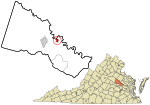Barrett Juvenile Correctional Center
1915 establishments in Virginia2005 disestablishments in VirginiaBuildings and structures in Hanover County, VirginiaDefunct prisons in VirginiaHistoric districts on the National Register of Historic Places in Virginia ... and 5 more
Infrastructure completed in 1915Juvenile detention centers in the United StatesNRHP infobox with nocatNational Register of Historic Places in Hanover County, VirginiaUse mdy dates from August 2023

The Barrett Juvenile Correctional Center, also known as the Barrett Learning Center and originally as the Virginia Industrial Home School for Wayward Colored Girls and then the Virginia Industrial Home School for Colored Girls, was a residential industrial school and later a juvenile correctional facility operated by the state of Virginia near Mechanicsville, Virginia.The facility was founded in 1915 as a facility for African-American girls who otherwise faced prison.
Excerpt from the Wikipedia article Barrett Juvenile Correctional Center (License: CC BY-SA 3.0, Authors, Images).Barrett Juvenile Correctional Center
Barrett Center Road,
Geographical coordinates (GPS) Address Nearby Places Show on map
Geographical coordinates (GPS)
| Latitude | Longitude |
|---|---|
| N 37.710833333333 ° | E -77.361666666667 ° |
Address
Barrett Center Road 11399
23116
Virginia, United States
Open on Google Maps










